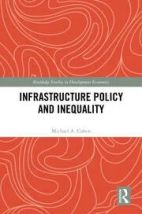Infrastructure Policy and Inequality

The definition of infrastructure itself has to be expanded beyond cement and pipes to include infrastructure as process, infrastructure as knowledge and information, infrastructure as institutions, infrastructure as people, infrastructure as nature, and infrastructure as intention. Without each of these definitions there is no hope for improving human well-being.
This is the central conclusion of a new book by Michael Cohen as he reflects on his 50-year engagement with urban infrastructure and other key urban issues. This included 27 years at the World Bank, helping develop new urban policies (including upgrading informal settlements and new house sites and services) and a much increased loan programme. In the 1990s, unhappy with how the Bank had become “… increasingly and visibly subordinated to the IMF”, he joined York University and then The New School to establish a new graduate programme in international affairs.
Thus, there are few who can rival the depth and detail in his new book Infrastructure Policy and Inequality.
This book has ten chapters. The first two explain how infrastructure can contribute to the achievements of socio-economic goals with chapters 3 to 7 providing a history of urban discussions and engagements with development assistance:
- The Early 1970s: Framing New Objectives for Development Assistance (including starting to lend to urban projects and defining policies for urban aid)
- Operationalizing the Urban Agenda: 1972–1982
- Strengthening Policies and Institutions for Urban Management, 1982–1991
- Cities and Economic Development: Shifting the Agenda in a World in Crisis: Crisis of 1990–1991.
These are followed by chapters on aid agencies and on how infrastructure can be used to reduce urban poverty. As stated in the first paragraph of this book note, this book addresses questions of how we shift our understanding of infrastructure beyond cement and pipes – in other words, seeing it as a way of reducing inequality with infrastructure as process, infrastructure as knowledge and information and so on.
The book has case studies of successes and failures, including a serviced site scheme that the World Bank supported during the 1970s in Senegal that was judged a failure in 1982. But given more time, by 2006 it prospered and showed that progressive investment over time in housing had clearly worked at scale.
In moving to conclusions, Michael Cohen reflects on what we have learned from international practice in urban infrastructure:
It was possible to provide low-cost urban infrastructure services to millions of poor people in diverse urban environments. This is in sharp contrast to the heavily subsidized “low-cost” housing favoured by aid agencies
- If given tenure over the land they were occupying, poor people would invest in building and improving their housing over time, in response to their own household needs and the wealth and income to which they had access
- The urban poor can be reliable borrowers of small credits and reliable clients for billed urban services such as water supply or electricity, if these charges are calculated from the outset to be affordable to low-income households
- It is possible to design slum upgrading programmes in which only a small minority of residents will have to be displaced in order to provide urban services
- Projects providing integrated packages of urban service improvements can have a higher financial rate of return than single sector projects
- Many urban building codes and regulatory arrangements discriminate against the poor by requiring high-cost materials and designs which are too expensive for poor households and which frequently do not respond to their needs
- The costs of displacement are very high and frequently badly managed, so that in situ improvements are easier to implement and more likely to avoid massive social disruption
- Participatory approaches frequently lead to more socially and politically sustainable outcomes than top-down methods. These approaches benefit from local knowledges to guide on-the-ground decisions.
But the author emphasizes how we also need to know what not to do. It starts from the idea that “helping people” does not mean doing things for them. It requires listening to their voices, recognizing the priority of their needs, and finding ways to design solutions which “the people” can see as their own. Over-simplifying complex situations does not get the job done. Rather it confuses expectations and creates the likelihood of severe surprises and disappointments later.
The author outlines what we have to do now – repurpose our understanding of and debates about infrastructure in order to transform infrastructure into an instrument to reduce structural inequalities or, phrased differently, to have a social objective. We must examine the infrastructure upon which our economies and societies are built. Rather than continue to accept that infrastructure is a necessary input to economic growth, we must ask how infrastructure can be repurposed and reframed to be a powerful tool to create a more equal distribution of income, wealth, opportunity and access to services.
Book note prepared by David Satterthwaite.
Search the Book notes database
Our Book notes database contains details and summaries of all the publications included in Book notes since 1993 - with details on how to obtain/download.
Use the search form above, or visit the Book notes landing page for more options and latest content.
For a searchable database for papers in Environment and Urbanization, go to http://eau.sagepub.com/

